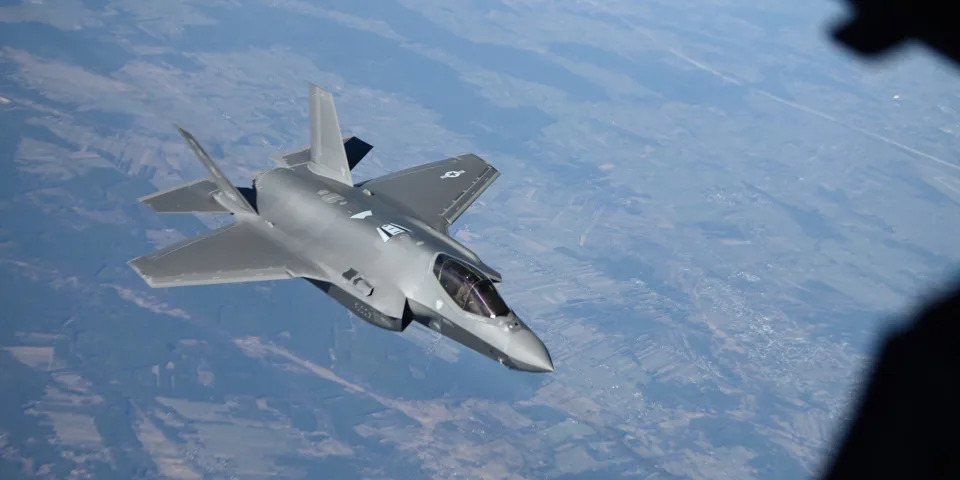Business Insider
The F-35 was ‘designed precisely’ to fight and win in the kind of war happening in Ukraine, former test pilot says
Constantine Atlamazoglou – April 17, 2022

- Russia’s war on Ukraine has shown what air warfare over a modern battlefield looks like.
- Neither side has the F-35, but it is designed for this environment, former test pilot Billie Flynn said.
- F-35s have “capabilities precisely focused on what we have been seeing in Ukraine,” Flynn said.
As the war in Ukraine approaches its third month, neither Russia nor Ukraine have been able to dominate the air, as both still have operational surface-to-air missile batteries and aircraft.
This makes the war in Ukraine unique among recent conflicts, and it provides useful lessons about how modern airframes would operate in contested airspace.
In an interview with The Aviationist on April 7, Billie Flynn, a former Canadian lieutenant colonel and senior F-35 test pilot for Lockheed Martin, highlighted the role that the F-35 could play in similar conditions.
“The F-35 was designed precisely for an environment that we are seeing in Ukraine now,” Flynn said.
The new generation

The F-35, built by Lockheed Martin, is one of two fifth-generation fighter jets used by the US, alongside the F-22 Raptor, and one of four in use around the world. China’s J-20 entered mass production in late 2021 and hasn’t seen combat. Russia’s Su-57 hasn’t entered mass production and has only deployed in a few limited missions in Syria.
A multirole stealth aircraft, the F-35 is intended for air-superiority and strike missions.
It is equipped with a powerful electronic-warfare and intelligence, surveillance, and reconnaissance suite. Those capabilities, which allow the F-35 to gather and distribute real-time battlefield information to friendly forces, have earned it the nickname “the quarterback of the skies.”
The weaponry it carries varies. In a configuration known as “beast mode” it carries four 500-pound GBU-12 laser-guided bombs on its wings, two GBU-12 in its internal weapons bay, and an AIM-9 air-to-air heat-seeking missile. That configuration sacrifices stealth for firepower.
When in stealth mode, the jet foregoes externally mounted weapons to preserve its low-observable profile.
There are three variants of the F-35. The F-35A is designed for conventional takeoffs and landings, the F-35B for short takeoffs and vertical landings, and the F-35C for aircraft-carrier operations.
A buffed-up team

In a contested airspace, the survivability of older fourth-generation fighter aircraft, like the ubiquitous F-16, will be limited, Flynn told The Aviationist.
F-16s are “not survivable in the very highly contested world,” like in Ukraine, where there are “significant numbers of sophisticated surface-to-air threats,” Flynn said.
However, the F-35’s ability to enhance the capabilities of friendly aircraft is exactly what would make it invaluable in a similar conflict, Flynn said.
“The F-35 was designed to operate in highly contested airspace, with capabilities precisely focused on what we have been seeing in Ukraine today. If you have F-35s, you do not necessarily need F-16s to do the damage that the F-35 would bring,” according to the former F-35 test pilot.
The F-35 would be particularly effective against surface-to-air missile systems and other ground defenses, neutralizing them and enemy aircraft to achieve air dominance.

The aircraft’s stealth profile will be one of its main advantages in doing so.
“Remember,” Flynn said, “we see them, they don’t see us. It’s like playing football, when one team’s invisible and the other team is not with a gross advantage on behalf of the F-35. F-35 would see all the enemy air-to-air threats and kill them all, plus completely neutralizing the surface-to-air missile threat to achieve air dominance.”
Once air dominance is achieved, aircraft like the F-16 can provide additional firepower against enemy ground forces, but even then the F-35 will be needed to protect them, according to Flynn.
The F-35 could also conduct close-air-support missions for troops on the ground. When friendly ground troops are in close contact with the enemy, however, the F-35 may have to use its less advanced armaments and accept more risk to do so.
“There may be a time when the troops are in contact and you’re going to come down and use the gun in the F-35,” Flynn said. “That’s a lot of risk for an $80 million F-35, but our job is to protect the troops on the ground.”
Flying solo

The US has repeatedly said that it will not become a combatant in Ukraine.
F-35s have been flying missions in stealth mode near Ukraine’s borders, though it’s not clear if they were conducting regular patrols to deter Russia or using their electronic capabilities to monitor forces in and around Ukraine.
Nevertheless, their presence so close to the conflict zone has had an impact, according to Flynn.
Having that jet flying along NATO’s eastern flank “is a significant deterrent” against Russian forces “continuing their ambitions to push further eastward. Because the F-35 represent an extraordinary lethal threat,” Flynn said.
The F-35’s “capacity to neutralize the enemy cannot be matched by any other airplane that flies in anybody else’s air force,” Flynn said. “So just the fact that the F-35s are there scares everybody on the other side.”
Constantine Atlamazoglou works on transatlantic and European security. He holds a master’s degree in security studies and European affairs from the Fletcher School of Law and Diplomacy.
